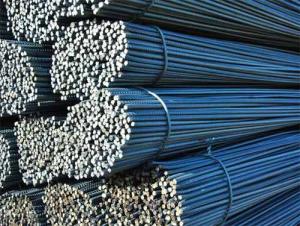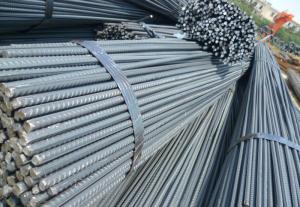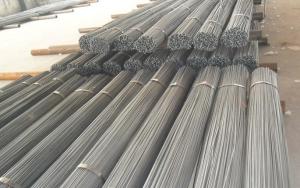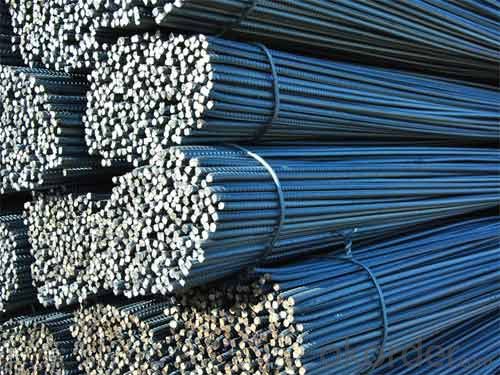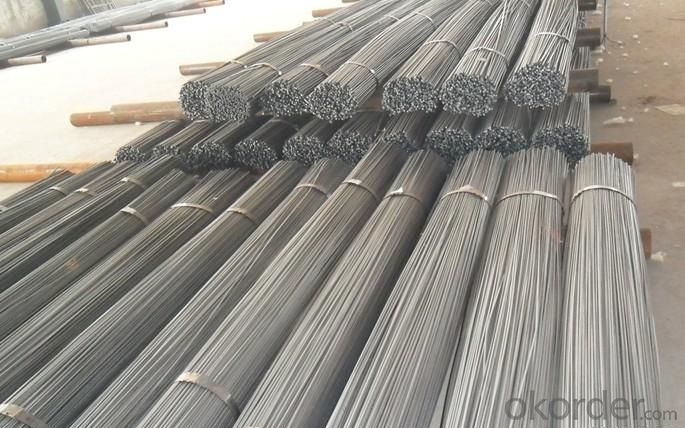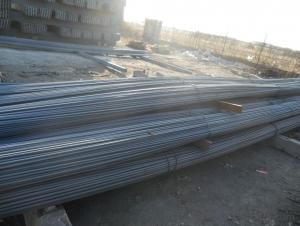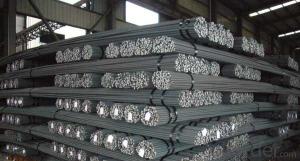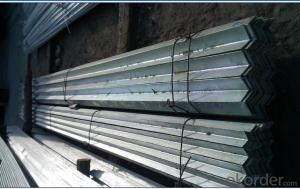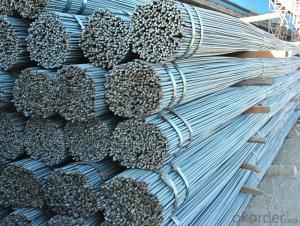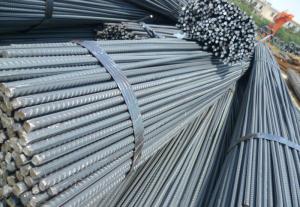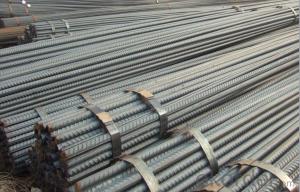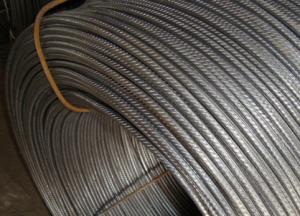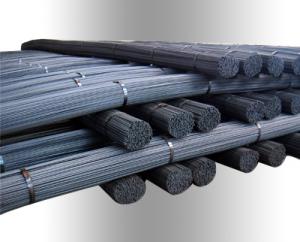Twelve mm Cold Rolled Steel Rebars with High Quality
- Loading Port:
- Tianjin
- Payment Terms:
- TT or LC
- Min Order Qty:
- 50 m.t.
- Supply Capability:
- 15000 m.t./month
OKorder Service Pledge
OKorder Financial Service
You Might Also Like
Specifications of Twelve mm Cold Rolled Steel Rebars with High Quality:
Name | Cold Rolled Steel Rebar | |
Diameter | 5mm, 5.5mm, 6mm, 6.5mm, 7mm, 8mm, 9mm, 10mm, 11mm, 12mm, | |
Length | 6M, 9M, 12M or as required | |
Price | Keep lower operating costs so as to offer competitive price for our clients | |
Label | to be specified by customer, generally, each bundle has 1-2 labels | |
Application | Building, construction | |
Invoicing | Actual or Theoretical Weight Basis as buyer’s request. | |
Theoretical weight and section area of each diameter of Twelve mm Cold Rolled Steel Rebars with High Quality as below for your information:
Diameter(mm) | Section area (mm²) | Mass(kg/m) | Weight of 12m (kg) | Pcs/ton |
12 | 113.04 | 0.888 | 10.656 | 93.84 |
Packaging & Delivery of Twelve mm Cold Rolled Steel Rebars with High Quality:
Packaging Detail: products are packed in bundle and then shipped by container or bulk vessel, deformed bar is usually naked strapping delivery, when storing, please pay attention to moisture proof. The performance of rust will produce adverse effect.
Each bundle weight: 2-3MT, or as required
Payment terms: TT payment in advance or Irrevocable LC at sight.
Trade terms :FOB, CFR, CIF
Delivery Detail: within 45 days after received advanced payment or LC.
FAQ:
Q1: Why buy Materials & Equipment from OKorder.com?
A1: All products offered byOKorder.com are carefully selected from China's most reliable manufacturing enterprises. Through its ISO certifications, OKorder.com adheres to the highest standards and a commitment to supply chain safety and customer satisfaction.
Q2: How do we guarantee the quality of our products?
A2: We have established an advanced quality management system which conducts strict quality tests at every step, from raw materials to the final product. At the same time, we provide extensive follow-up service assurances as required.
Q3: How soon can we receive the product after purchase?
A3: Within three days of placing an order, we will arrange production. The shipping date is dependent upon the quatity, how many sizes you want and the plan of production, but is typically 1 month to 2 month days from the beginning of production.
Images of Twelve mm Cold Rolled Steel Rebars with High Quality:
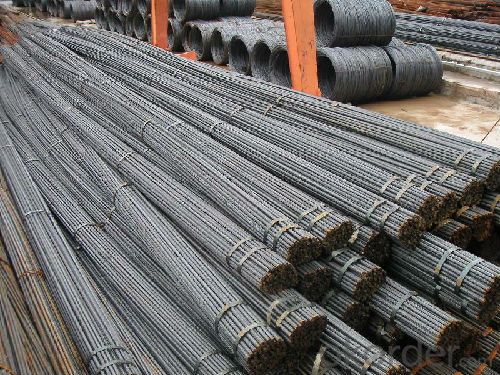
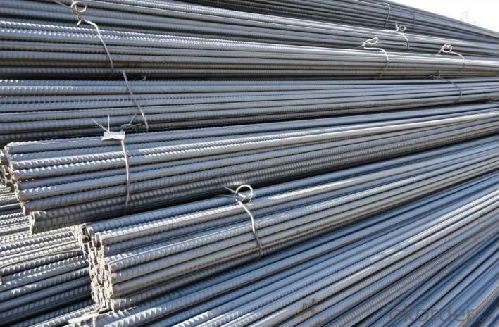
- Q: How do steel rebars contribute to the seismic performance of a structure?
- Steel rebars contribute to the seismic performance of a structure by enhancing its strength and ductility. When embedded in concrete, rebars act as reinforcement, providing tensile strength to resist the forces generated during an earthquake. This reinforcement helps prevent cracking and failure in the concrete, allowing the structure to better absorb and dissipate seismic energy. Additionally, the flexibility and high yield strength of steel rebars enable them to deform and absorb seismic forces, reducing the likelihood of structural collapse during an earthquake.
- Q: How are steel rebars marked for identification on construction sites?
- Steel rebars are typically marked with a series of symbols, numbers, and colors to identify their size, grade, and other specifications. These markings are usually either painted or embossed on the surface of the rebars, making it easier for construction workers to identify and use them correctly during the construction process.
- Q: How long do steel rebars typically last in construction?
- Steel rebars typically last for the entire lifespan of a structure, which is typically several decades or even longer.
- Q: How do steel rebars improve the ductility of a structure?
- By reinforcing and resisting tension forces, steel rebars enhance the ductility of a structure. When external loads, like earthquakes or strong winds, are applied to a structure, it undergoes tensile stresses, which can result in cracking and failure. However, the inclusion of steel rebars, typically composed of high-strength steel, in concrete structures improves their capacity to withstand and distribute these forces. The presence of rebars in the concrete boosts its tensile strength, enabling it to withstand deformation and cracking. When the structure faces tension, the rebars bear the majority of the load, preventing the concrete from collapsing. This redistribution of forces leads to increased ductility, which refers to a material's ability to undergo deformation without breaking. Moreover, steel rebars also fortify the structural integrity of a building by hindering the propagation of cracks. As the concrete cracks under tension, the rebars act as a barrier, confining the growth of these cracks and preventing them from spreading throughout the structure. This containment of cracks enhances the overall resilience of the building, minimizing the risk of catastrophic failure. In conclusion, steel rebars are vital in enhancing the ductility of a structure by improving tensile strength, redistributing forces, and limiting crack propagation. By incorporating rebars into concrete, engineers can design and construct structures capable of withstanding various external forces, assuring the safety and longevity of the building.
- Q: How are steel rebars protected from fire damage?
- Steel rebars are typically protected from fire damage through the application of fire-resistant coatings or by encasing them within fire-resistant materials, such as concrete. This helps to prevent the steel rebar from reaching its critical temperature, which could compromise its structural integrity.
- Q: How are steel rebars protected against alkali attacks?
- Various techniques and materials are used to protect steel rebars from alkali attacks. One commonly employed method involves the application of a protective coating onto the surface of the rebars. This coating acts as a barrier, preventing direct contact between the steel and the alkaline environment. Epoxy, zinc, and polyethylene are frequently utilized coatings that are designed to provide long-lasting protection against alkali attacks. Another approach to safeguarding rebars is the use of corrosion inhibitors. These inhibitors are added to the concrete mixture during construction and work by reducing the corrosive effects of alkali on the rebars. By forming a protective film on the steel surface, corrosion inhibitors prevent alkali from reaching the rebar and causing damage. In addition to coatings and corrosion inhibitors, the proper design of the concrete mix is also essential in protecting rebars from alkali attacks. By optimizing the composition of the concrete mix, engineers can decrease the alkalinity of the surrounding environment, thereby minimizing the risk of alkali attacks and subsequent corrosion. To ensure the continued protection of steel rebars against alkali attacks, regular maintenance and inspection of structures are crucial. It is essential to monitor the condition of the rebars and promptly address any signs of corrosion or damage, as this is vital to their long-term durability. In summary, the combination of protective coatings, corrosion inhibitors, proper concrete mix design, and regular maintenance are key factors in safeguarding steel rebars against alkali attacks. By implementing these measures, the lifespan and structural integrity of concrete structures can be significantly extended.
- Q: How do steel rebars prevent corrosion in concrete structures?
- Steel rebars prevent corrosion in concrete structures through a process called passivation. When rebars are embedded in concrete, the alkaline environment of the concrete causes the formation of a protective oxide layer on the surface of the steel. This oxide layer acts as a barrier, preventing the penetration of oxygen and moisture that are necessary for corrosion to occur. Additionally, rebars are often coated with epoxy or galvanized to provide an extra layer of protection against corrosion.
- Q: How do steel rebars contribute to the load-bearing capacity of structures?
- Steel rebars contribute to the load-bearing capacity of structures by providing reinforcement and strength to concrete. When embedded within the concrete, rebars increase its tensile strength, allowing it to withstand higher loads and prevent cracking or collapsing. This reinforcement enhances the overall structural integrity and durability of buildings, bridges, and other construction projects.
- Q: What are the common defects found in steel rebars?
- Steel rebars can exhibit several common defects. One such defect is surface cracks, which may arise from either the manufacturing process or mishandling and inadequate storage. These cracks have the potential to compromise the rebars' strength and integrity, thereby increasing the risk of failure under load. Another frequently encountered defect is corrosion, which occurs when rebars are exposed to moisture or chemicals. This corrosion weakens the rebars and diminishes their load-bearing capacity, rendering them more susceptible to failure. Bending and straightening defects are also commonly observed in steel rebars. Improper bending or straightening techniques can result in cracks, buckling, or uneven distribution of stress, thereby compromising the performance of the rebars. Inadequate welding or improper lapping of rebars can lead to subpar connections and reduced structural integrity. Welding defects, such as lack of fusion, incomplete penetration, or excessive porosity, weaken the rebars and heighten the risk of failure. Dimensional defects, encompassing variations in diameter, length, or straightness, can impact the fit and compatibility of rebars with other structural components. When rebars are not correctly aligned or fail to meet the required dimensions, it can lead to diminished structural strength and compromised performance. Lastly, improper heat treatment during the manufacturing process can result in internal defects like segregation, inclusions, or improper grain structure. These defects undermine the rebars' strength and render them more susceptible to fracture or failure under load. In summary, it is crucial to thoroughly inspect steel rebars for these common defects to ensure the structural integrity and safety of the construction projects in which they are employed.
- Q: How do steel rebars perform in fire-resistant constructions?
- Steel rebars perform well in fire-resistant constructions due to their high melting point and thermal conductivity. They can withstand high temperatures for an extended period without significant deformation or loss of strength. This makes them suitable for reinforcing concrete structures in fire-prone areas, providing stability and structural integrity during a fire. Additionally, the thermal conductivity of steel helps to dissipate heat, reducing the risk of localized temperature increases that could compromise the overall fire resistance of the construction.
Send your message to us
Twelve mm Cold Rolled Steel Rebars with High Quality
- Loading Port:
- Tianjin
- Payment Terms:
- TT or LC
- Min Order Qty:
- 50 m.t.
- Supply Capability:
- 15000 m.t./month
OKorder Service Pledge
OKorder Financial Service
Similar products
Hot products
Hot Searches
Related keywords
